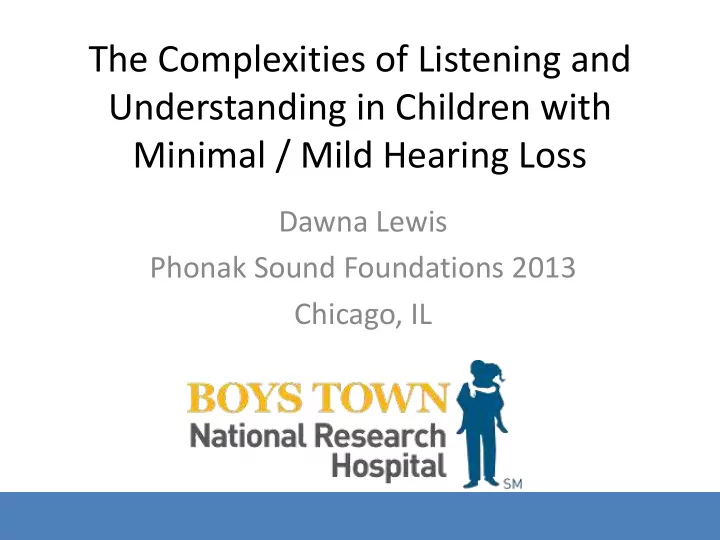

The Complexities of Listening and Understanding in Children with Minimal / Mild Hearing Loss Dawna Lewis Phonak Sound Foundations 2013 Chicago, IL
Definitions of MMHL • Heterogeneous group of hearing loss configurations • All losses may be conductive or sensorineural Bilateral Unilateral High Frequency Minimal: 16-25 dB HL Affected ear > 20 dB HL >25 dB HL for 2 or more Mild: 25-45 dB HL frequencies above 2 kHz • Represent over 5% of school-age children (Bess et al, 1998; Niskar et al, 1998)
What are the effects of minimal/mild hearing loss on children? • The answers are not always as clear as we’d like them to be • What does research tell us?
Potential Difficulties Academic/ Communication Psychosocial Cognitive • Soft/distant • Grade retention • Teacher ratings speech • Additional • Perceived • Noise/ educational functional health reverberation assistance • Physical, social, • Localization • Verbal academic emotional tests functioning • Listening effort • Full-scale IQ • Attention • Speech/language (Bess et al., 1986; Bess et al., 1998; Bess & Tharpe, 1986; Borton et al., 2010; Crandell, 1993; Culbertson & Gilbert, 1986; English & Church, 1999; Johnson et al., 1997; Klee & Davis-Dansky, 1986; Lieu et al., 2010, 2012; Porter et al. 2013; Ruscetta et al., 2005; Newton, 1983; Oyler et al., 1987, 1988) 4
Similarities Academic/ Communication Psychosocial Cognitive • Standardized • IQ • Behavior Language • Verbal • Teacher ratings measures of performance • Non-verbal • Speech • Self-concept • Full scale perception in • Quality of life • Reading quiet • Academic Skills • Speech perception in noise Bess et al., 1998; Borton et al., 2010; Crandell, 1993; Culbertson & Gilbert, 1986; Klee & Davis- Dansky, 1986; Lewis et al., submitted; Lieu et al., 2010, 2012; Porter et al., 2013) 5
Why can’t we all agree? • Heterogeneity of hearing losses within the same population • Perceptions • Tests
Heterogeneity of Hearing Losses
Perceptions • Person with MMHL may not realize what is being missed • Perceptions of difficulties may influence expectations, behaviors, and progress If a tree falls…….?
Effects of Minimal/Mild Hearing Loss: Children’s, Parents’, Teachers’ Perceptions Subjects • 20 children (8-12 years) with unilateral or bilateral MMHL • One parent/guardian of each child • One classroom teacher for 10 of the children Procedures • Structured interviews were conducted • Broad topic areas Analysis • Qualitative and quantitative methods
Challenge versus No-Challenge 60% 50% Child: No Challenge % of All Coded Utterances Child: Challenge 14.9% 40% 17.4% Parent: No Challenge 7.3% 11.9% 15.7% 8.2% Parent: Challenge 30% Teacher: No Challenge 20% Teacher: Challenge 5.4% 33.2% 31.5% 28.8% 28.6% 27.0% 26.2% 7.6% 10% 5.3% 15.2% 9.2% 6.8% 0% Awareness / Groups/ Limited Visual Understanding Noise Access
Challenges Reported as Not Related to Hearing Loss (Triads only) 40 Parent 35 Teacher Number of Occurrences 30 25 20 15 10 5 0 Personality Control Negative Academic Attention Same as Behavior Challenges Normal Hearing 11
What do these preliminary results suggest? • Perspectives are important – Clinician/family/educator understanding – Counseling – Habilitation – Critical review of the literature
Tests • Who/what/where/when are you testing? • Sensitivity to potential problems
Comprehension and sentence recognition by Children with MMHL in a simulated classroom environment (Lewis et al., submitted) • Previous work in our lab – children adults with NH (Valente et al., 2012) • Participants – 18 children (8-12 yrs) with NH and 18 with MMHL • 8 with bilateral HL • 10 with unilateral HL – Age-matched – WASI 2FSIQ within 1.25 SD of mean – All testing completed without amplification
• Testing took place in a simulated classroom with • Acoustical environment control of acoustics, noise and listening tasks • Neutral spectrum • Realistic classroom background noise, HVAC learning task : systems at 50 dBA • video recordings of talkers positioned around • Talkers presented at 60 the subject, dBA • Teacher + 4 Students • +10 dB SNR at listening location • Speech recognition task: • Sentence repetition • 600 ms RT60 at 1 kHz • Single talker, auditory- only • Quasi-randomly from the 5 loudspeakers
Looking Behavior • Proportion of Events Visualized – How often listeners looked directly at the talker as he/she was speaking during the classroom learning task • Overall looking behavior
Results • Sentence Recognition • All except 2 children with MMHL scored > 89% • Comprehension • Significant effect of age and HL (p<.05) • No age x HL interaction
Looking Behavior • How often did listeners look directly at the talker as he/she was speaking? • No significant differences across age or HL and no interactions
• Looking behavior • No significant differences across age or HL and no interactions • MMHL children show a different pattern of looking behavior than the NH children
What do these results tell us? • Despite performing at or near ceiling on a sentence recognition task, younger children with NH and children with MMHL perform more poorly than older children with NH on more complex listening tasks • Individual looking behaviors vary – Under some conditions, it is possible that attempting to visualize the talker may inefficiently utilize cognitive resources that would otherwise be allocated for comprehension
Summary • Multiple factors can influence how we understand the potential difficulties that may be experienced by children with MMHL • Tasks representing the types of listening and learning activities experienced in classrooms under plausible acoustic conditions may be better indicators of real-world speech understanding in these environments than simple speech recognition tasks
Thanks for listening!
Recommend
More recommend